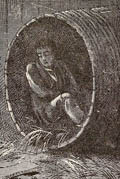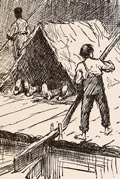
Back to
About This Site

Forward to
Acknowledgements
|
This project started from the presumption that I could use the far-flung resource called the Internet to give students of Mark Twain access to the particular and often rare resources of the Barrett Collection of American Literature at the University of Virginia Library. Many of Mark Twain's works still speak directly to modern readers, but the larger story of his career -- as best-selling writer, live performer, celebrity and American icon -- can be more fully appreciated when those works are located in the context of his times. By means of the Web, for example, students around the world can flip through the sales prospectus of Huck Finn and see for themselves how this classic American novel was described and sold to its original readers in 1885 -- and since the copy they are using is a virtual one, the real prospectus isn't being worn out. I began naively, thinking only about my own expectations. My original ambition was to digitize and organize as much primary material as possible. As I have built the site, however, I have learned from the reactions of my own students about the expectations people bring with them to the Internet. It quickly became obvious that when my students sat in front of a computer, they were looking for pictures, not words, and for a more interactive experience than just reading a text. The desire to take real advantage of the Internet and the computer as resources has led me to look for ways to re-present the story of Mark Twain in his times. At present, then, this site aspires to be both a permanent electronic archive and an evolving virtual exhibition. As an archive, it contains a growing number of searchable primary texts: of Mark Twain's works, of contemporary reviews, of advertisements, and so on. As an ongoing experiment in ways of using the capabilities of computers to help people explore the meaning of a writer's achievement, it contains several different kinds of interactive displays: Since Net users are looking for graphic images, what parts of the story can pictures tell? Can the issue of Huck Finn and racism be articulated by the various American illustrations of Jim? The display of Mark Twain's various signatures also attempts visually to articulate a specific interpretive issue -- Clemens, Twain and identity -- but in addition tries to give users more interactive control. Translating Innocents Abroad into a hypertext map explores what is gained and lost when a narrative text is reconceptualized in graphic (and geographic) terms that allow readers to move into and out of it in non-linear ways. As both archive and experiment the site remains very much in progress. I've already had the benefit of a lot of help (see Acknowledgements), but I will be grateful for all the additional help I can get. If you have either a contemporary newspaper review or an idea about a new way to display as aspect of Mark Twain's career in this electronic medium, I hope you'll send it along. I'm also interested in your reactions to what is already here. The great and terrible thing about an electronic project is that it never has to be finished. |
 Back to About This Site |
 Forward to Acknowledgements |